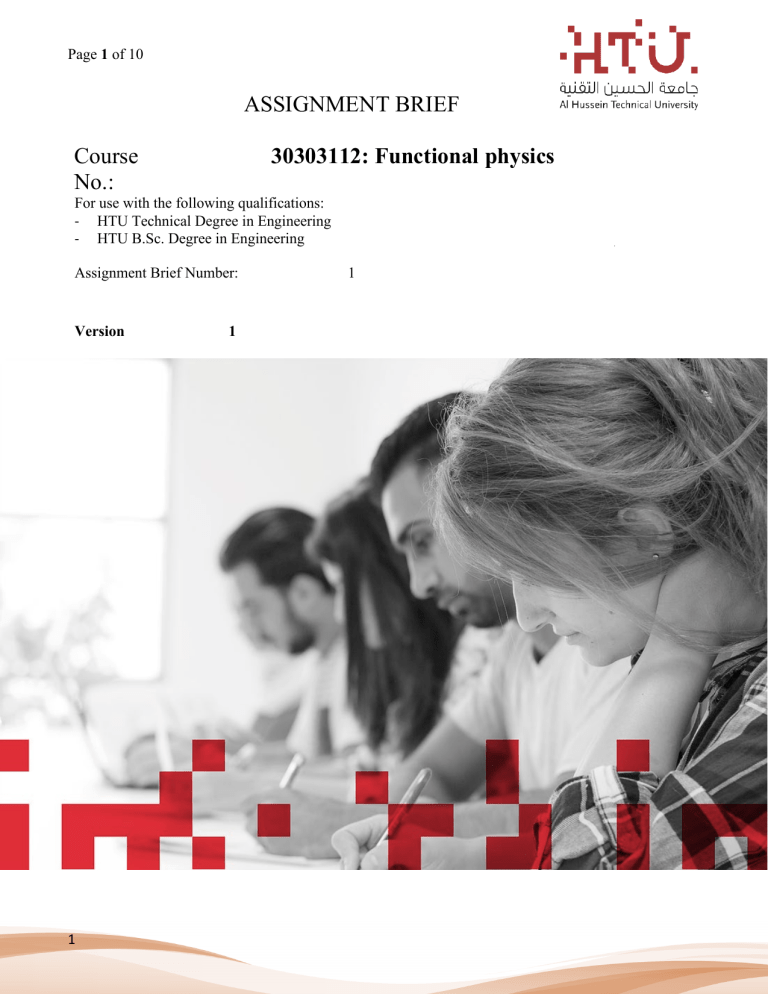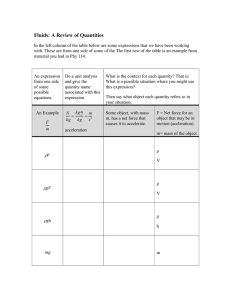
Page 1 of 10
ASSIGNMENT BRIEF
30303112: Functional physics
Course
No.:
For use with the following qualifications:
- HTU Technical Degree in Engineering
- HTU B.Sc. Degree in Engineering
Assignment Brief Number:
Version
1
1
1
Page 2 of 10
Assignment Brief
Student Name/ID
Number/Section
HTU Course
Number and Title
Academic Year
Assignment
Author
Course Tutor
Assignment Title
Assignment Ref
No
Issue Date
Formative
Assessment dates
Submission Date
IV Name & Date
010303110: Functional physics
2020/2021
Ismail Hammoudeh
Ismail Hammoudeh
Motion in one and two dimensions
Assignment 1
14 August 2021
15 August 2021
Dr. Mohammad AlAzzeh
Submission Format
Provide your answers on separate A4 sheets. Write your name and the page number on
each sheet. Handwriting must be clear. Box your final answers. This is a strictly
individual assignment and no collaboration amongst students is allowed. You must
include all the relevant steps, information, calculations, diagrams, etc….
Unit Learning Outcomes
LO1- Understanding physical quantities with different units of measurements.
LO2- Acquire knowledge and understanding of physical facts, terminology, concepts
related to kinematics
2
Page 3 of 10
Assignment Brief and Guidance
Question 1
A)
A stone was thrown vertically upwards from
the top of a building that is160 m heigh with an
initial speed of 10 m/s at time tin=0. When the
stone returned, it missed the edge of the
building and went to collide with the ground at
time t=tf. For the whole time interval, when the
stone was in the air, calculate the following 8
physical quantities numerically (assuming g =
10ms-2). [Put the final answers in the table to
the right]
B)
A car was moving with a constant speed of 75
km/h passed by a policeman, who decided to
catch it and give it a ticket. After a delay of 5
seconds, the policeman was following the car
with a constant speed of 80 km/h. When he
caught up with the car:
(1) what was the covered distance from the
first point they met? ……………………
(2) after how many seconds after their first
meeting was that? ………………………
(3) Draw a suitable graph of motion that
explains, how to solve this problem
C)
Saeed drives from home to the university in 3
phases:
Phase 1) constant acceleration of the car from
rest to a speed of 93.6 km/h in 11 seconds,
Phase 2) constant speed for 36 seconds.
Phase 3) constant decelarion beginning at a
distance of 320 m before the university park
place.
-
3
Sketch the relevant (v-t)- and (x-t)graphs
Calculate:
Page 4 of 10
(1) His average speed in km/h
……………………….
(2) His acceleration one second before
he parks ……………………
(3) The driving duration Δt
……………………..
(4) The distance between his home
and the university
……………………
Question 2:
A) {Q}SI is the unit of Q in the SIsystem. {Q}French is the unit of Q in
the cm-g-s-system. Work is force times displacement. The
ratio, {Work}SI/{Work}French = 10n. Calculate n
n=
B) The force acting on an object is a function of time: F(t)= a t + b t2, where t is time
measured in seconds and F is Force measured in Newtons.
a. What is the difference between Newtons and seconds in the SI-system?
……………………………………………………………………………………………………………………………………….
b. Calculate the dimensions of the constants, a and b:
c. Find the SI-unit of a2b
[a]=
[b]=
{a2b}SI=
C) The natural (Plank) Unit of a physical quantity Q has the form: {Q}Plank= ℏn1 𝑐𝑐 n2 𝐺𝐺 n3
where: the Plank constant: ℏ = 1.0545717260000002 x 10−34 kg m2 s −1
the light speed:
c = 299792458 m/s
and the universal constant of gravity: = 6.673848 x 10−11 kg −1 m3 s−2
n1, n2 and n3 are suitable numbers that ensure the correct dimension of Q.
Example: {velocity}Plank=c=3.00x108 m/s [n1=0, n2=1, n3=0]
Calculate the natural unit of
n1=
Time {t}Plank (3 significant figures)
n2=
{t}Plank=
x 10or m/s2
[find n1, n2, n3 and take
n3=
special care of the order of
magnitude]
D) Find the area of Palestine in square miles: APalestine=27000km2= x mile2. Find x.
Use: 1 mile=5280 ft … 1ft=12 inch … 1inch=2.54 cm
x=
4
Page 5 of 10
Question.3 Match the following a-v-x-graphs of motion (one case is solved)
5
Page 6 of 10
Question 4:
A masspoint follows the shown trajectory
from point A to point E according to the
equations of motion: x(t) = 5 cosπt + 3 ;
y(t) = 5 sinπt – 4 (in relevant SI-units).
Part I:
For point D consider the following 5
physical quantities Qi, i=1…5: time –
position – speed – velocity –
acceleration
1. Which are scalars? …………………………………
………………………………………………………………………
2. Which are vectors? Sketch them on the
plot…………………………………………………………………
………………………………………………………………………
3. Calculate all 5 quantities:
tD=…………………………………………………………………
xD=………………………………………………………………
SpD=……………………………………………………………
vD=………………………………………………………………
aD=………………………………………………………………
4. Which 2 vectors are perpendicular to
eachother? Why? ……………………………………
…………………………………………………………………………
…………………………………………………………………………
5. Find a point P among {A,B,C,E} where QP=QD for one of the 5 Qs. What is the physical
quantity, Q, and what is the point, P? Q=…………………………………………, P=…………………………………………
Part II:
Consider the distance and displacement between A and E.
1. Are they vectors or scalars? ……………………………………………………………………………………………………………
2. Compare their magnitudes (use <>=) ………………………………………………………………………………………………
3. Calculate their magnitudes:
|DistanceAE|=……………………………………..……………………|DisplacementAE|=…………………………………………………
Part III:
Consider the acceleration at point C and the average acceleration between B and D
1. Are they vectors or scalars? ……………………………………………………………………………………………………………
2. Compare their magnitudes (use <>=) ………………………………………………………………………………………………
3. Calculate their magnitudes: |aC|=……………………………………..……, |<a>BD|= …………………………………………
4. If they have directions, compare them: ……………………………………………………………………………………………
5. What is the cause of acceleration according to dynamics? …………………………………………………………
……………………………………………………………………………………………………………………………………………………………………
6. Give some physical examples of such causes………………………………………………………………………………
7. Show that this motion is in some sense UNIFORM
………………………………………………………………………………………………………………………………………………………………………
………………………………………………………………………………………………………………………………………………………………………
6
Page 7 of 10
Question 5:
The figure shows the motion of a light table
tennis ball under the Influence of a constant
net force consisting of constant gravity and
constant wind force. A is the take-off point, B
is the point with maximum height, h, and C is
the point of impact with the ground, R meters
(range) away from the take-off point, A.
The equations of motion (in relevant SI-units)
are: x(t)=-t2+2t and y(t)=-3t2+3t
The acceleration due to gravity is everywhere:
agr=-10 j m/s2
1.
Show that this motion is uniformly
accelerated (Find anet)
…………………………………………………………………………………
………………………………………………………………………………………
……………………………………………………………………………………………
…………………………………………
Sketch agr , aw (acceleration due to wind force) and anet at point B (with correct ratios)
What is the geometric name of this path of the projectile? ……………………………………………………………………………………
Compare the speeds at A, B, and C (use <=>) ……………………………………………………………………………………
Calculate the speeds at A, B, and C [vA=……………………………………………………., vB=………………………..………….…………….,
vC=………………………………………….]
6. Estimate the distance covered by the projectile between A and C [D=…………………….…………………….]
7. Calculate the average velocity between A and C
2.
3.
4.
5.
8. [ <v>=
.………………………………………………i
+
j]
Now, with no wind, the challenge is to
repeat the experiment with a small solid
glass ball preserving the height and the
range of the light table tennis ball. See the
required path (dashed green path)
..…………………….…………………………
1. Determine the take-off angle
[θ= ……………………………………………………………]
2. Calculate the initial speed
[v0 =…………………………………………………………….]
3. Determine the position, where the
projectile has its minimal speed
[x=………………..…………………, y=……………………..………..………..……]
4. Determine the time when the projectile
has its minimal speed [t=……………………...…….…………….]
5. Calculate the minimal speed of the flying projectile [vmin=…………………..……………………]
6. Calculate the average velocity between A and C [ <v>=.……………………………………………i + ..…………………………………………… j ]
7
Page 8 of 10
Learning Outcomes and Assessment Criteria
Learning Outcome
Pass
LO1- Understanding physical P1 Use and convert
quantities with different units unit systems for
of measurements.
various physical
quantities
P2 Differentiate
between vector and
scalar quantities
Merit
M1 Obtain the units of
derived quantities in
terms of base units
M2 Apply dimensional
analysis to validate the
correctness of physical
expressions
P3 Identify the base
and derived physical
quantities and
LO2- Acquire knowledge and
understanding of physical
facts, terminology, concepts
related to kinematics
P4 Demonstrate basic
understanding of
kinematic quantities for
motion in simple 1D
P5 Demonstrate basic
understanding of freely
falling situation and
M3 Compare the
kinematic values
obtained from analytical
methods to the
quantities derived from
calculus
M4 Carry out
calculations and
procedures to effectively
evaluate a freely falling
P6 Construct or read
graphs relating physical situation and find all
quantities and
requested information
effectively employ
graphs to solve a given M5 Carry out
calculations and
problem.
procedures to effectively
evaluate a 2D motion
problems
8
Distinction
D1 Critically
suggest logical
values for specific
fundamental and
derived quantities.
D2 Apply
dimensional
analysis to derive
certain physical
expressions
D3 Critically
analyze a given
situation and
predict the results
for a certain
problem based on
the data given
D4 Carry out
calculations and
procedures to
effectively evaluate
a projectile
situation and find
all requested
information.
Page 9 of 10
STUDENT ASSESSMENT SUBMISSION AND
DECLARATION
When submitting evidence for assessment, each student must sign a declaration confirming that the work is
their own.
Student name and No.:
Issue date:
14/08/2021
Assessor name:
Submission
date:
Submitted on:
15/08/2021
Programme:
BTEC Course Number and Title:: --------HTU Course Number and Title : functional physics
Assignment number and title: 1
Plagiarism
Plagiarism is a particular form of cheating. Plagiarism must be avoided at all costs and students who break
the rules, however innocently, may be penalised. It is your responsibility to ensure that you understand
correct referencing practices. As a university level student, you are expected to use appropriate references
throughout and keep carefully detailed notes of all your sources of materials for material you have used in
your work, including any material downloaded from the Internet. Please consult the relevant unit lecturer or
your course tutor if you need any further advice.
Student Declaration
Student declaration
I certify that the assignment submission is entirely my own work and I fully understand the
consequences of plagiarism. I understand that making a false declaration is a form of malpractice.
Student signature:
9
Date:
Page 10 of 10
Kinematics Equations you may need:
For Particle Under Constant Velocity:
𝑥𝑥𝑓𝑓 = 𝑥𝑥𝑖𝑖 + 𝑣𝑣𝑥𝑥 𝑡𝑡
For Particle Under Constant Acceleration:
𝑣𝑣𝑥𝑥𝑥𝑥 = 𝑣𝑣𝑥𝑥𝑥𝑥 + 𝑎𝑎𝑥𝑥 𝑡𝑡
𝑣𝑣𝑥𝑥𝑥𝑥 + 𝑣𝑣𝑥𝑥𝑥𝑥
𝑣𝑣𝑥𝑥,𝑎𝑎𝑎𝑎𝑎𝑎 =
2
1
𝑥𝑥𝑓𝑓 = 𝑥𝑥𝑖𝑖 + (𝑣𝑣𝑥𝑥𝑥𝑥 + 𝑣𝑣𝑥𝑥𝑥𝑥 )𝑡𝑡
2
1
𝑥𝑥𝑓𝑓 = 𝑥𝑥𝑖𝑖 + 𝑣𝑣𝑥𝑥𝑥𝑥 𝑡𝑡 + 𝑎𝑎𝑥𝑥 𝑡𝑡 2
2
2
2
𝑣𝑣𝑥𝑥𝑥𝑥 = 𝑣𝑣𝑥𝑥𝑥𝑥 + 2𝑎𝑎𝑥𝑥 (𝑥𝑥𝑓𝑓 − 𝑥𝑥𝑖𝑖 )
10



